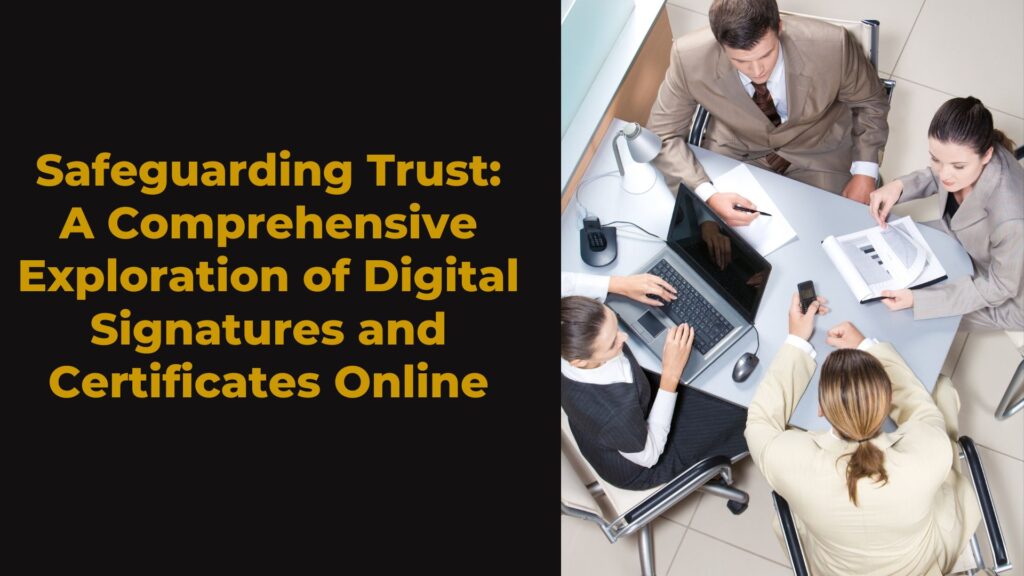
Safeguarding Trust: A Comprehensive Exploration of Digital Signatures and Certificates Online
In today’s rapidly evolving digital landscape, ensuring the integrity and authenticity of online transactions, communications, and documents is paramount. With the rise of e-commerce, online banking, electronic contracts. And digital communications, the need for robust security measures has never been greater. Among the most crucial tools in the arsenal of cybersecurity are digital signatures and certificates.
This comprehensive article aims to delve into the intricate world of digital signatures and certificates, elucidating their significance, functionality, and the mechanisms behind their operation. From understanding the fundamental concepts to exploring real-world applications and emerging trends. We will embark on a journey to grasp the essence of these vital components of modern-day cybersecurity.
Understanding Digital Signatures
At its core, a digital signature is a cryptographic technique used to validate the authenticity and integrity of a digital message, document, or transaction. Unlike traditional handwritten signatures, digital signatures rely on mathematical algorithms to generate unique identifiers that can only be produced by the original signer. This process ensures that any alterations to the signed content are immediately detectable, thereby safeguarding against tampering and forgery.
Digital signatures operate on the principles of public-key cryptography, utilizing a pair of keys – a private key known only to the signer and a public key available to anyone who wishes to verify the signature. When a document is signed digitally. The signer applies their private key to generate a unique digital fingerprint, or hash, of the content. This hash is then encrypted with the signer’s private key, producing the digital signature. To verify the signature, the recipient uses the signer’s public key to decrypt the signature and compare the resulting hash with a freshly computed hash of the received content. If the hashes match, the signature is deemed valid.
Exploring Digital Certificates
While digital signatures provide a robust mechanism for individual authentication and data integrity. They require a means of securely distributing and managing public keys. This is where digital certificates come into play. A digital certificate, also known as a public key certificate, serves as a trusted credential that binds a public key to its rightful owner. Essentially, it acts as a digital passport, validating the identity of individuals, organizations, or entities operating in the digital realm.
Digital certificates are issued by trusted third-party entities known as certificate authorities (CAs). These CAs verify the identity of certificate applicants before issuing digital certificates. Thereby establishing trust in the authenticity of the associated public keys. Furthermore, digital certificates contain additional information, such as the certificate holder’s name. The issuing CA’s signature, and the certificate’s expiration date, all of which contribute to enhancing security and trust in online interactions.
Real-World Applications
The proliferation of digital signatures and certificates has revolutionized numerous sectors, ranging from finance and healthcare to government and beyond. In the realm of e-commerce, digital signatures enable secure online transactions, ensuring that sensitive financial information remains confidential and unaltered during transmission. Likewise, in healthcare, digital signatures facilitate the electronic exchange of medical records and prescriptions while adhering to stringent privacy regulations.
Moreover, digital certificates play a pivotal role in establishing secure communication channels over the internet. Transport Layer Security (TLS), the successor to Secure Sockets Layer (SSL), relies on digital certificates to encrypt data transmitted between web servers and clients. Thereby safeguarding against eavesdropping and man-in-the-middle attacks. Additionally, code signing certificates are used to authenticate software applications and ensure their integrity, mitigating the risk of malware and unauthorized modifications.
Emerging Trends and Challenges
As technology continues to advance, new trends and challenges emerge in the realm of digital signatures and certificates. One such trend is the adoption of blockchain technology for decentralized authentication and digital identity management. Blockchain-based solutions offer a distributed and tamper-resistant ledger for storing digital certificates. Enhancing transparency and eliminating single points of failure inherent in traditional certificate authorities.
However, alongside these innovations come persistent challenges, including the risk of private key compromise, certificate misuse, and regulatory compliance. As cyber threats evolve in sophistication, organizations must remain vigilant in implementing robust security measures, such as multi-factor authentication, cryptographic key management. And regular security audits, to mitigate risks and uphold the integrity of digital signatures and certificates.
Suggested Read: E-Mudhra Digital Signature Certificate
Conclusion
Digital signatures and certificates represent indispensable tools for ensuring the integrity, authenticity. And confidentiality of online transactions and communications. By leveraging cryptographic techniques and trusted third-party validation, these technologies enable secure interactions in an increasingly interconnected world. As organizations and individuals continue to embrace digitalization. Understanding the principles and practices of digital signatures and certificates becomes essential for safeguarding trust and preserving the integrity of the digital ecosystem.






Leave Your Comment